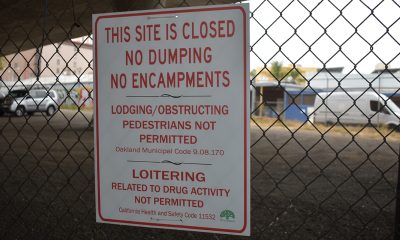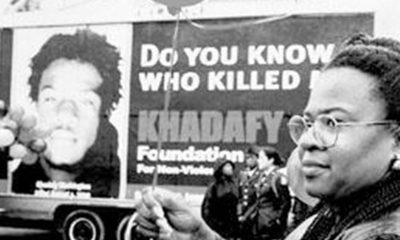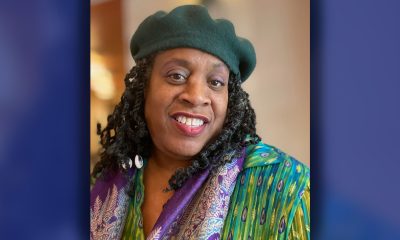National
The 1st Successful American-Born Magician Was a Black Man
Henry Louis Gates Jr. and Julie Wolf, THE ROOT
(TheRoot.com)—Who was America’s first successful stage magician?
He swallowed swords and molten lead. He danced on eggs without cracking their shells. He threw knives; he threw his voice. He was Richard Potter, the first American-born stage magician and ventriloquist, black or white. Prior to Potter’s career in the early 19th century, the performance of magic and ventriloquism had been the domain of white European men.
Born in Hopkinton, Mass., around 1783, the year the American Revolution ended, on the plantation of the slave owner Sir Charles Henry Frankland—who may or may not have been his father—Potter set sail for England as a cabin boy when he was just 10 years old. Once there, he met a Scottish magician and ventriloquist named John Rannie, and he was captivated. For years they performed in Europe, but in 1800 they traveled to America, joining a traveling circus and crisscrossing the North and South. (As Jim Haskins and Kathleen Benson explain in their book Conjure Times, Potter was able to travel safely in the South because, in his assistant’s role, he was perceived as Rannie’s servant.)
###
Community
New Filing: Trump’s Attempts to Overturn 2020 Election Were Part of Private Scheme, Not Official Acts
NNPA NEWSWIRE — The filing reveals the extent of Trump’s interactions with figures such as attorney Rudy Giuliani and other senior officials, some of whose names were withheld. Trump persisted with a plan to undercut Joe Biden’s victory despite numerous warnings from people in his circle that his claims of a stolen election were untrue.

By Stacy M. Brown, NNPA Newswire Senior National Correspondent
@StacyBrownMedia
Special Counsel Jack Smith has delivered a powerful legal blow to former President Donald Trump, unveiling new evidence that the twice-impeached Trump’s efforts to overturn the 2020 election results were part of a private scheme rather than actions taken in his official capacity as president.
In a 165-page legal brief unsealed Wednesday, Smith provided new details about Trump’s behind-the-scenes maneuvers to subvert the election, including pressure campaigns targeting key officials, attempts to create false electors, and private discussions with his vice president, Mike Pence.
The filing reveals the extent of Trump’s interactions with figures such as attorney Rudy Giuliani and other senior officials, some of whose names were withheld. Trump persisted with a plan to undercut Joe Biden’s victory despite numerous warnings from people in his circle that his claims of a stolen election were untrue.
Smith’s brief is part of a broader strategy to prove that Trump can face trial for his actions, even after a Supreme Court ruling granted him immunity for official acts as president. The special counsel argues that Trump’s efforts to enlist Pence in blocking Congress’s certification of the election results were part of a private, illegal campaign to retain power, not part of his official duties.
“At its core, the defendant’s scheme was a private criminal effort,” Smith wrote in the filing. “In his capacity as a candidate, he used deceit to target every stage of the electoral process.”
The document provides new evidence of Trump’s attempts to sway election officials in critical swing states to alter the results in his favor. The brief quotes a lawyer advising Trump, who gave an “honest assessment” that his claims of widespread fraud would not withstand scrutiny in court. Yet, Trump dismissed the warning. “The details don’t matter,” Trump said, according to the filing.
Further, the brief recounts private conversations between Trump and Pence, in which Pence urged Trump to accept defeat and consider another run in 2024. Trump, however, expressed reluctance, saying, “2024 is so far off.”
Smith’s filing depicts Trump’s actions as part of a desperate and illegal campaign to remain in power after losing the 2020 election. The brief also points to Trump’s reliance on Giuliani and other private allies in his election subversion attempts, asserting that none of these efforts fell under the scope of presidential duties.
“The defendant asserts that he is immune from prosecution for his criminal scheme to overturn the 2020 presidential election because, he claims, it entailed official conduct,” the filing reads. “Not so. Although the defendant was the incumbent president during the charged conspiracies, his scheme was fundamentally a private one.”
A sealed appendix to the legal brief contains FBI interviews, search warrant affidavits, and grand jury testimony that might soon become public. Smith’s filing builds on the indictment released last year, expanding the evidence and reinforcing the argument that Trump’s conduct was criminal and not shielded by presidential immunity.
Smith concluded the brief with an explicit request to the court: “The government respectfully submits that the defendant’s conduct described in this motion is not subject to presidential immunity and that he should face trial for his private acts of subversion.”
Business
Special Interview: Rep. Barbara Lee Discusses Kamala Harris’ Plan for Black Men
On Oct. 16, California Black Media (CBM) spoke with Harris-Walz campaign surrogate, Congresswoman Barbara Lee (D-CA-12), who shared more insights on Harris’ agenda and the importance of securing the Black Male vote. “She has said very clearly that she wants to earn the vote of everyone. And that means earning the vote of Black men,” said Lee of Harris. “She understands the systemic and historic challenges that Black men have. You haven’ t heard of a presidential candidate coming up with a concrete actual plan and policy agenda.” The agenda includes five focus areas based on insights she gleaned from hosting discussions with Black men during her Economic Opportunity Tour.

By Edward Henderson, California Black Media
Last week, the Kamala Harris campaign released its Opportunity Agenda for Black Men.
On Oct. 16, California Black Media (CBM) spoke with Harris-Walz campaign surrogate, Congresswoman Barbara Lee (D-CA-12), who shared more insights on Harris’ agenda and the importance of securing the Black Male vote.
“She has said very clearly that she wants to earn the vote of everyone. And that means earning the vote of Black men,” said Lee of Harris. “She understands the systemic and historic challenges that Black men have. You haven’ t heard of a presidential candidate coming up with a concrete actual plan and policy agenda.”
The agenda includes five focus areas based on insights she gleaned from hosting discussions with Black men during her Economic Opportunity Tour:
- Provide 1 million loans that are fully forgivable to Black entrepreneurs and others disadvantaged groups to start businesses.
- Champion education, training, and mentorship programs that help Black men get good-paying jobs in high-demand industries It will also develop more accessible pathways for Black men to become teachers.
- Support a regulatory framework for cryptocurrency and other digital assets so Black men who invest in and own these assets are protected.
- Launch a National Health Equity Initiative focused on Black men that addresses sickle cell disease, diabetes, mental health, prostate cancer, and other health challenges that disproportionately impact them.
- Legalize recreational marijuana and creating opportunities for Black Americans to succeed in this new industry.
“[Vice President Harris] knows that Black men have long felt that too often their voice in our political process has gone unheard and that there is so much untapped ambition and leadership within the Black male community,” the language in the agenda states. “Black men and boys deserve a president who will provide the opportunity to unleash this talent and potential by removing historic barriers to wealth creation, education, employment, earnings, health, and improving the criminal justice system.”
Diving into Harris’ agenda, Lee says, reminded her of her own record of supporting Black men over the years as an elected official. In the 90’s, she established the first California Commission on African American Males through which she pressured the state to address urgent economic, health and social challenges specific to Black men.
“No group of people are a monolithic group of people,” said Lee She’ s not taking any vote for granted. I’ve known her over three decades and I believe she is being herself. She’ s authentic,” Lee added.
Each of the 5 key points addressed in the Harris Campaign’s agenda, Lee says, has additional clauses that can potentially help Black men and their families thrive. This includes lowering rent; up to $25,000 in downpayment help for first time homebuyers; and cutting taxes for Black men in lower-wage jobs by increasing the Earned Income Tax Credit maximum to $1,500.
“I think the messages is one of empowerment for Black men — regardless of whether they’ re a blue-collar worker, if they’ re not working, if they’ re in business, if they’ re an entrepreneur, whatever background or whatever they’re doing or experiencing life. I think the authenticity of their experience can only be articulated through them,” said Lee.
Activism
Advanced Conductors Provide Path for Grid Expansion
Several reconductoring projects have been initiated in Belgium and the Netherlands, and utility companies in the U.S. have used the material to string transmission lines across wide spans like river crossings. That technology, however, has not made its way to the majority of overhead power lines that feed residential and commercial customers.

By Matthew Burciaga
UC Berkeley News
Utility companies in the United States could double electric transmission capacity by 2035 by replacing existing transmission lines with those made from advanced materials, according to a new study published Monday in the Proceedings of the National Academy of Sciences.
Led by Duncan Callaway, professor and chair of the Energy and Resources Group (ERG), and Amol Phadke, an affiliate and senior scientist at the Goldman School of Public Policy, the first-of-its-kind study details a faster and more cost-effective way to expand the grid and connect the more than 1,200 gigawatts of renewable energy projects awaiting approval. The analysis was first published last December as a working paper by the Energy Institute at Haas and has been covered by the New York Times, the Washington Post, Heatmap News, and other news outlets.
“Expanding transmission capacity is critical to decarbonization, and we sought to study ways to build it faster and cheaper,” said Callaway.
It currently takes 10 to 15 years to build a new power line and the U.S. is building transmission lines at a lower rate than it was in the past decade. Without sufficient capacity, renewable energy projects often sit in limbo for years as transmission operators study what upgrades—if any—are needed to accommodate the increased loads.
The authors modeled various scenarios to determine if replacing existing transmission conductors with those made with advanced composite-core materials—a process known as reconductoring—could provide a pathway to faster grid expansion.
Several reconductoring projects have been initiated in Belgium and the Netherlands, and utility companies in the U.S. have used the material to string transmission lines across wide spans like river crossings. That technology, however, has not made its way to the majority of overhead power lines that feed residential and commercial customers.
“As we learned more about the technology, we realized that no one had done the detailed modeling needed to understand the technology’s potential for large-scale transmission capacity increases,” said Phadke.
Based on the authors’ projections, it is cheaper—and quicker—for utility companies to replace the 53,000 existing transmission lines with advanced composite-core materials than it is to build entirely new transmission lines.
They assert that doing so would reduce wholesale electricity costs by 3% to 4% on average—translating to $85 billion in system cost savings by 2035 and $180 billion by 2050.
“The level of interest we’ve received from federal and state agencies, transmission companies and utilities is extremely encouraging, and since our initial report, the Department of Energy has committed hundreds of millions of dollars to reconductoring projects,” said co-author Emilia Chojkiewicz, a PhD student in ERG and an affiliate of the Goldman School of Public Policy. “We are looking forward to learning about these projects as they unfold.”
Additional co-authors include Nikit Abhyankar and Umed Paliwal, affiliates at the Goldman School of Public Policy; and Casey Baker and Ric O’Connell of GridLab, a nonprofit that provides comprehensive technical grid expertise to policy makers and advocates.
-

 Bay Area4 weeks ago
Bay Area4 weeks agoFormer Mayor Willie L. Brown Endorses Dana Lang for BART Board District 7
-

 Bay Area4 weeks ago
Bay Area4 weeks agoMayor Sheng Thao Issues Executive Order to Shut Down Homeless Encampments
-

 Bay Area4 weeks ago
Bay Area4 weeks agoOakland Xi Gamma Omega Honors the Chapter’s First Regional Director
-

 Commentary4 weeks ago
Commentary4 weeks agoOpinion: In First Presidential Debate, Harris Exposes Trump’s Inadequacies
-

 Art4 weeks ago
Art4 weeks agoPhenomenal Woman’ Maya Angelou Monument Unveiled at San Francisco Main Library
-

 Community4 weeks ago
Community4 weeks agoCalifornia’s Aging Services Offer Valuable Resources for Older Adults
-

 Bay Area4 weeks ago
Bay Area4 weeks agoOakland at Its Best… A Glimpse: Uniting the Community and Supporting Future Generations
-

 Bay Area4 weeks ago
Bay Area4 weeks agoRemembering Khadafy Washington: His Memory Has Inspired Hope and Healing in Oakland for 24 years
































































